PEUGEOT 5008 2016 Owners Manual
Manufacturer: PEUGEOT, Model Year: 2016, Model line: 5008, Model: PEUGEOT 5008 2016Pages: 364, PDF Size: 12.98 MB
Page 251 of 364
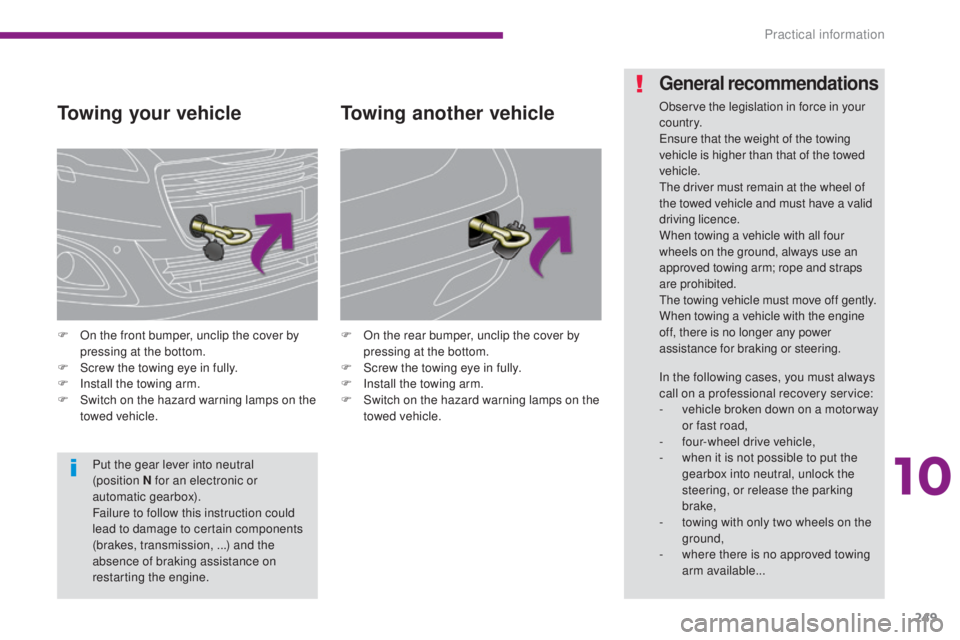
249
5008_en_Chap10_infos-pratiques_ed01-2015
Towing your vehicle
F On the front bumper, unclip the cover by pressing at the bottom.
F
S
crew the towing eye in fully.
F
I
nstall the towing arm.
F
S
witch on the hazard warning lamps on the
towed vehicle. F
O n the rear bumper, unclip the cover by
pressing at the bottom.
F
S
crew the towing eye in fully.
F
I
nstall the towing arm.
F
S
witch on the hazard warning lamps on the
towed vehicle.
Towing another vehicle
Put the gear lever into neutral
(position N for an electronic or
automatic gearbox).
Failure to follow this instruction could
lead to damage to certain components
(brakes, transmission,
...) and the
absence of braking assistance on
restarting the engine.
General recommendations
Observe the legislation in force in your
c o unt r y.
Ensure that the weight of the towing
vehicle is higher than that of the towed
vehicle.
The driver must remain at the wheel of
the towed vehicle and must have a valid
driving licence.
When towing a vehicle with all four
wheels on the ground, always use an
approved towing arm; rope and straps
are prohibited.
The towing vehicle must move off gently.
When towing a vehicle with the engine
off, there is no longer any power
assistance for braking or steering.
In the following cases, you must always
call on a professional recovery service:
-
v
ehicle broken down on a motor way
or fast road,
-
f
our-wheel drive vehicle,
-
w
hen it is not possible to put the
gearbox into neutral, unlock the
steering, or release the parking
brake,
-
t
owing with only two wheels on the
ground,
-
w
here there is no approved towing
arm available...
10
Practical information
Page 252 of 364

250
5008_en_Chap10_infos-pratiques_ed01-2015
Towbar with quickly detachable towball
Fitting
F Below the rear bumper, unclip and remove the protective cover on the carrier. F
B
efore fitting the towball, check that the
points of contact, indicated by the arrows,
are clean. U se a soft clean cloth.F
E
nsure that the towball is fully engaged.
The two pins must be in contact with
the cut-outs in the carrier and the
trigger
B must have returned to the
"locked" position.
F I nstall and clip in place the protective
cover, by rotating it to the left.
F
O
n the towball, press and hold control A .
F
R
elease the locking mechanism by
pressing the trigger B . F
P
ut the end of the towball into the carrier,
located below the bumper, as far as it will go.
No tools are required to install or remove the towball on this genuine towbar system.
F
C
onnect the trailer plug to the 13 -way
socket provided, located next to the carrier.
F
M
ake the trailer safe by attaching its safety
cable to the eye provided for this purpose,
located on the carrier.
Practical information
Page 253 of 364

251
5008_en_Chap10_infos-pratiques_ed01-2015
When the towball is installed, it may
inter fere with the complete opening of
the lower tailgate.
Take care to avoid the tailgate coming
into contact with the towball.
F
U
nclip and remove the protective cover, by
turning it to the right.
Removing
F Press the trigger B and remove the towball by pulling it towards you.
F
O
n the towball, press and hold control A .
F
R
elease the locking mechanism by
pressing the trigger B . F
C
lip the protective cover in place on the
carrier located below the bumper. If the towball is not locked in place, the
trailer could separate. There is a risk of
an accident.
Always lock the towball in the way
described.
Observe the legislation in force in the
country in which you are driving.
Remove the towball when it is not
being used.
Before setting off, check that the trailer
lighting and signalling works correctly.
Maximum authorised nose weight:
70 kg.
Refer to the "Technical data" section for
the maximum weights and towed loads
for your vehicle.
Carrying system (box or bicycle carrier).
You must not exceed the maximum
nose weight on the towbar: if this weight
is exceeded, the device could detach
from the vehicle and cause a serious
accident.
10
Practical information
Page 254 of 364
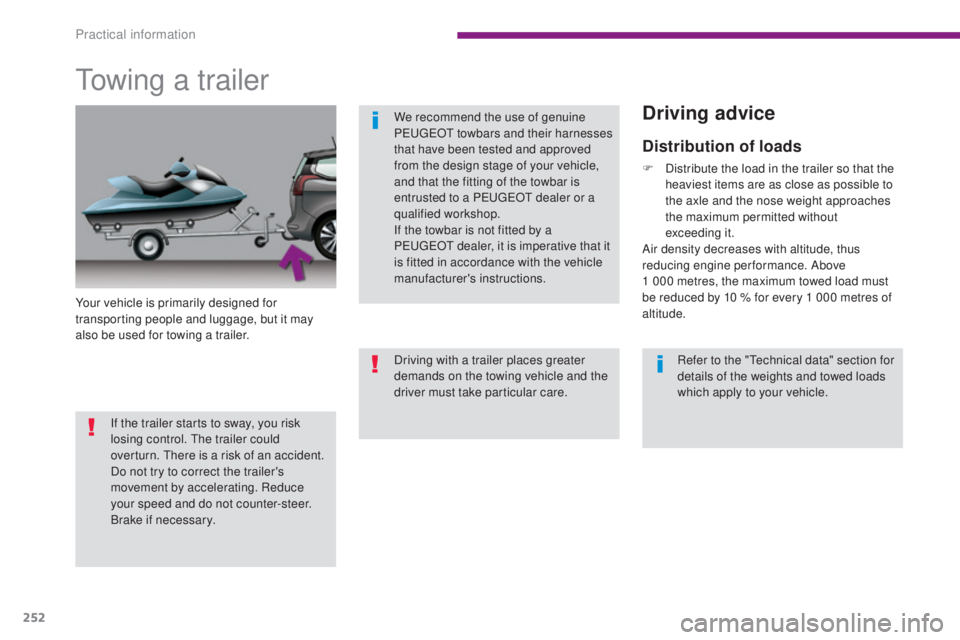
252
5008_en_Chap10_infos-pratiques_ed01-2015
Towing a trailer
Your vehicle is primarily designed for
transporting people and luggage, but it may
also be used for towing a trailer.Refer to the "Technical data" section for
details of the weights and towed loads
which apply to your vehicle.
We recommend the use of genuine
PEUGEOT towbars and their harnesses
that have been tested and approved
from the design stage of your vehicle,
and that the fitting of the towbar is
entrusted to a PEUGEOT dealer or a
qualified workshop.
If the towbar is not fitted by a
PEUGEOT dealer, it is imperative that it
is fitted in accordance with the vehicle
manufacturer's instructions.
Driving with a trailer places greater
demands on the towing vehicle and the
driver must take particular care.
If the trailer starts to sway, you risk
losing control. The trailer could
overturn. There is a risk of an accident.
Do not try to correct the trailer's
movement by accelerating. Reduce
your speed and do not counter-steer.
Brake if necessary.
Driving advice
Distribution of loads
F Distribute the load in the trailer so that the heaviest items are as close as possible to
the axle and the nose weight approaches
the maximum permitted without
exceeding
it.
Air density decreases with altitude, thus
reducing engine performance. Above
1
000 metres, the maximum towed load must
be reduced by 10
% for every 1 000 metres of
altitude.
Practical information
Page 255 of 364

253
5008_en_Chap10_infos-pratiques_ed01-2015
Side wind
F Take into account the increased sensitivity to side wind.
Cooling
Towing a trailer on a slope increases the
temperature of the coolant.
As the fan is electrically controlled, its cooling
capacity is not dependent on the engine speed.
F
T
o lower the engine speed, reduce your
speed.
The maximum towed load on a long incline
depends on the gradient and the ambient
temperature.
In all cases, keep a check on the coolant
temperature.
Braking
Towing a trailer increases the braking distance.
To avoid overheating of the brakes on a long
mountain type of descent, the use of engine
braking is recommended.
Ty r e s
F Check the tyre pressures of the towing vehicle and of the trailer, observing the
recommended pressures.
Lighting
F Check the electrical lighting and signalling on the trailer.
The rear parking sensors will be
deactivated automatically if a genuine
PEUGEOT towbar is used.
F
I
f the warning lamp and the
STOP
warning lamp come on, stop the
vehicle and switch off the engine as
soon as possible.
10
Practical information
Page 256 of 364
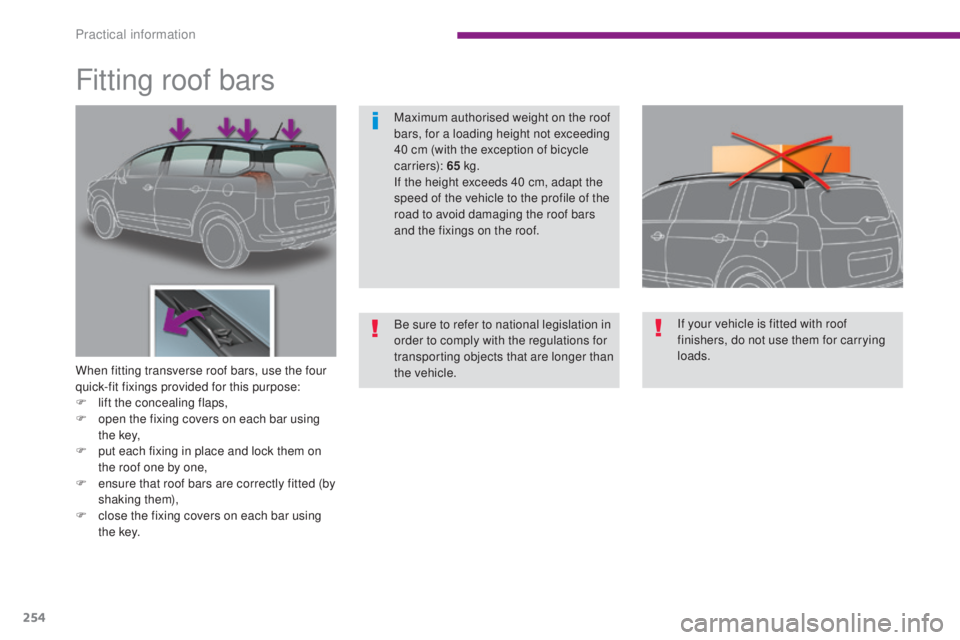
254
5008_en_Chap10_infos-pratiques_ed01-2015
Fitting roof bars
When fitting transverse roof bars, use the four
quick-fit fixings provided for this purpose:
F
l
ift the concealing flaps,
F
o
pen the fixing covers on each bar using
t h e key,
F
p
ut each fixing in place and lock them on
the roof one by one,
F
e
nsure that roof bars are correctly fitted (by
shaking them),
F
c
lose the fixing covers on each bar using
t h e key. If your vehicle is fitted with roof
finishers, do not use them for carrying
loads.
Maximum authorised weight on the roof
bars, for a loading height not exceeding
40 cm (with the exception of bicycle
c a r r i e r s): 65
kg.
If the height exceeds 40 cm, adapt the
speed of the vehicle to the profile of the
road to avoid damaging the roof bars
and the fixings on the roof.
Be sure to refer to national legislation in
order to comply with the regulations for
transporting objects that are longer than
the vehicle.
Practical information
Page 257 of 364

255
5008_en_Chap10_infos-pratiques_ed01-2015
Removal
F Unclip the upper part of the screen, starting at the edges.
F
T
ake the screen by the lower edges and
detach it by pulling it towards you.
Very cold climate screen
F Offer up the screen, placing the lower clips in contact with lower section of the lower
grille, using the centre guide as an aid.
F
C
lip first the lower part, then the upper
part, from the middle out towards the
edges.
Fitting
Removable protective screen which prevents the accumulation of snow at the radiator cooling fan.
Before fitting or removing the screen, ensure that the engine is off and the cooling fan has stopped. It is recommended that the screen be fitted and
removed by a PEUGEOT dealer or a qualified workshop.
Do not forget to remove the very cold
climate screen:
-
w
hen the ambient temperature
exceeds 10° C,
-
w
hen towing,
-
a
t speeds above 75 mph (120 km/h).
10
Practical information
Page 258 of 364
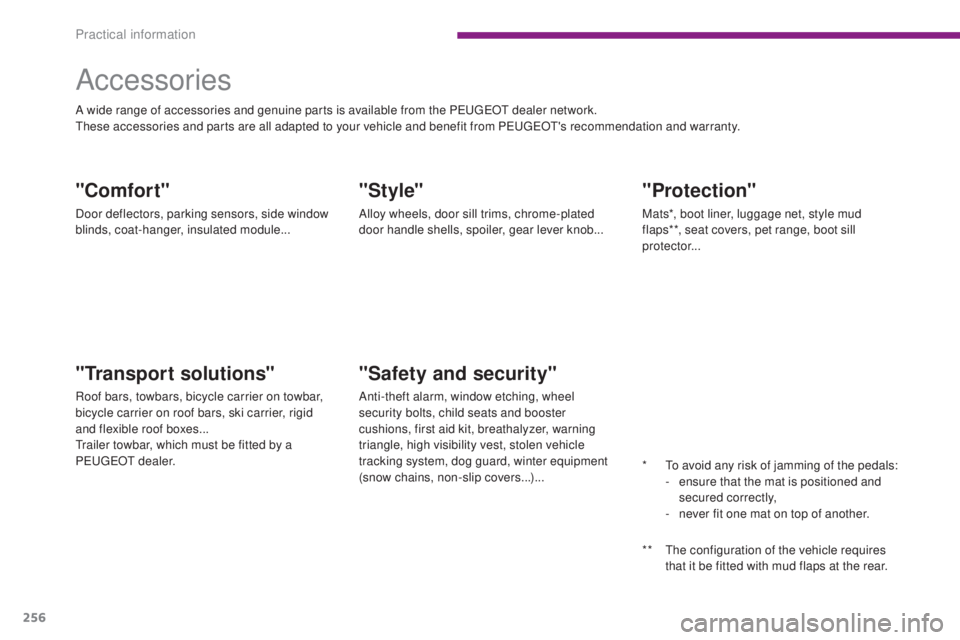
256
5008_en_Chap10_infos-pratiques_ed01-2015
"Protection"
Mats*, boot liner, luggage net, style mud
flaps**, seat covers, pet range, boot sill
protector...
"Safety and security"
Anti-theft alarm, window etching, wheel
security bolts, child seats and booster
cushions, first aid kit, breathalyzer, warning
triangle, high visibility vest, stolen vehicle
tracking system, dog guard, winter equipment
(snow chains, non-slip covers...)...
Accessories
"Style"
Alloy wheels, door sill trims, chrome-plated
door handle shells, spoiler, gear lever knob...
"Transport solutions"
Roof bars, towbars, bicycle carrier on towbar,
bicycle carrier on roof bars, ski carrier, rigid
and flexible roof boxes...
Trailer towbar, which must be fitted by a
PEUGEOT dealer.
"Comfort"
Door deflectors, parking sensors, side window
blinds, coat-hanger, insulated module... A wide range of accessories and genuine parts is available from the PEUGEOT dealer network.
These accessories and parts are all adapted to your vehicle and benefit from PEUGEOT's recommendation and warranty.*
T
o avoid any risk of jamming of the pedals:
-
e
nsure that the mat is positioned and
secured correctly,
-
n
ever fit one mat on top of another.
**
T
he configuration of the vehicle requires
that it be fitted with mud flaps at the rear.
Practical information
Page 259 of 364
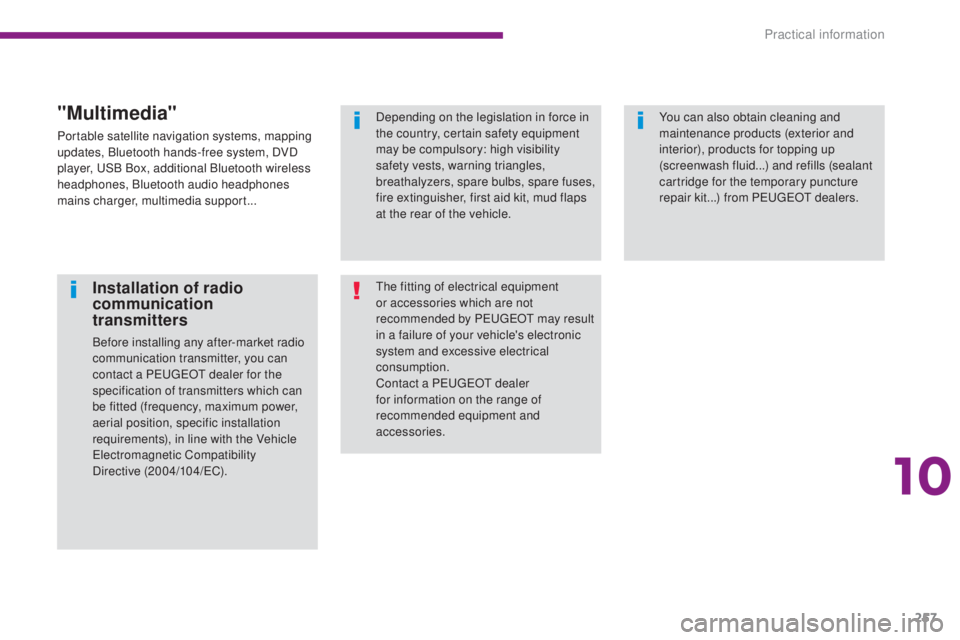
257
5008_en_Chap10_infos-pratiques_ed01-2015
Installation of radio
communication
transmitters
Before installing any after-market radio
communication transmitter, you can
contact a PEUGEOT dealer for the
specification of transmitters which can
be fitted (frequency, maximum power,
aerial position, specific installation
requirements), in line with the Vehicle
Electromagnetic Compatibility
Directive (2004/104/EC).The fitting of electrical equipment
or accessories which are not
recommended by PEUGEOT may result
in a failure of your vehicle's electronic
system and excessive electrical
consumption.
Contact a PEUGEOT dealer
for information on the range of
recommended equipment and
accessories. Depending on the legislation in force in
the country, certain safety equipment
may be compulsory: high visibility
safety vests, warning triangles,
breathalyzers, spare bulbs, spare fuses,
fire extinguisher, first aid kit, mud flaps
at the rear of the vehicle.
You can also obtain cleaning and
maintenance products (exterior and
interior), products for topping up
(screenwash fluid...) and refills (sealant
cartridge for the temporary puncture
repair kit...) from PEUGEOT dealers.
"Multimedia"
Portable satellite navigation systems, mapping
updates, Bluetooth hands-free system, DVD
player, USB Box, additional Bluetooth wireless
headphones, Bluetooth audio headphones
mains charger, multimedia support...
10
Practical information
Page 260 of 364
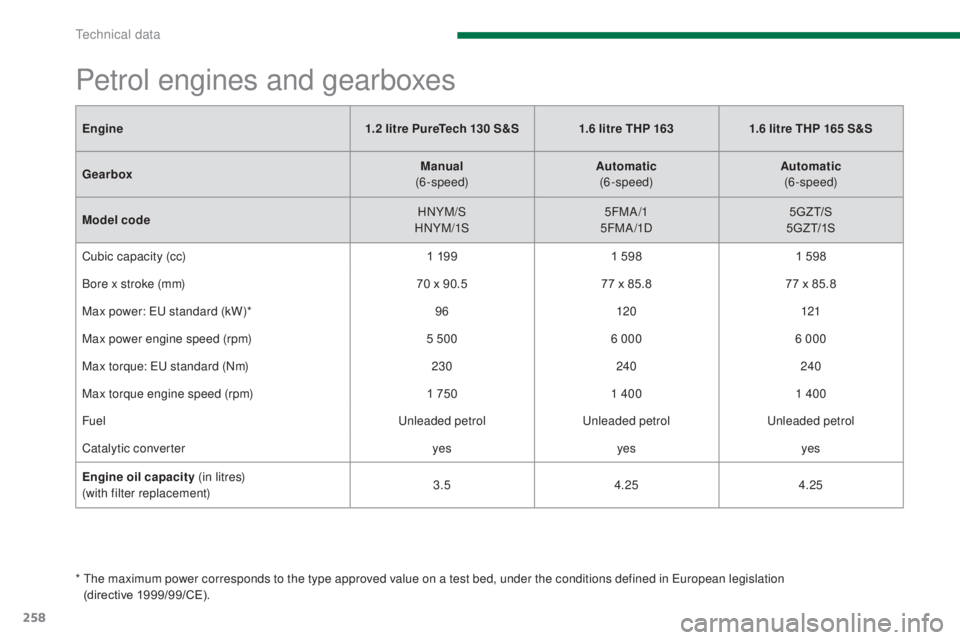
258
5008_en_Chap11_caracteristiques_ed01-2015
Engine1.2 litre PureTech 130 S&S 1.6 litre THP 163 1.6 litre THP 165 S&S
Gearbox Manual
(6-speed) Automatic
(6-speed) Automatic
(6-speed)
Model code HNYM/S
HNYM/1S 5FMA /1
5FM A /1D 5G Z T/S
5G Z T/1S
Cubic capacity (cc) 1 1991 598 1 598
Bore x stroke (mm) 70 x 90.577 x 85.8 77 x 85.8
Max power: EU standard (kW)* 96120 121
Max power engine speed (rpm) 5 5006 000 6 000
Max torque: EU standard (Nm) 230240240
Max torque engine speed (rpm) 1 7501 400 1 400
Fuel Unleaded petrolUnleaded petrolUnleaded petrol
Catalytic converter yesyesyes
Engine oil capacity (in litres)
(with filter replacement) 3.5
4.25 4.25
Petrol engines and gearboxes
* The maximum power corresponds to the type approved value on a test bed, under the conditions defined in European legislation
(directive 1999/99/CE).
Technical data